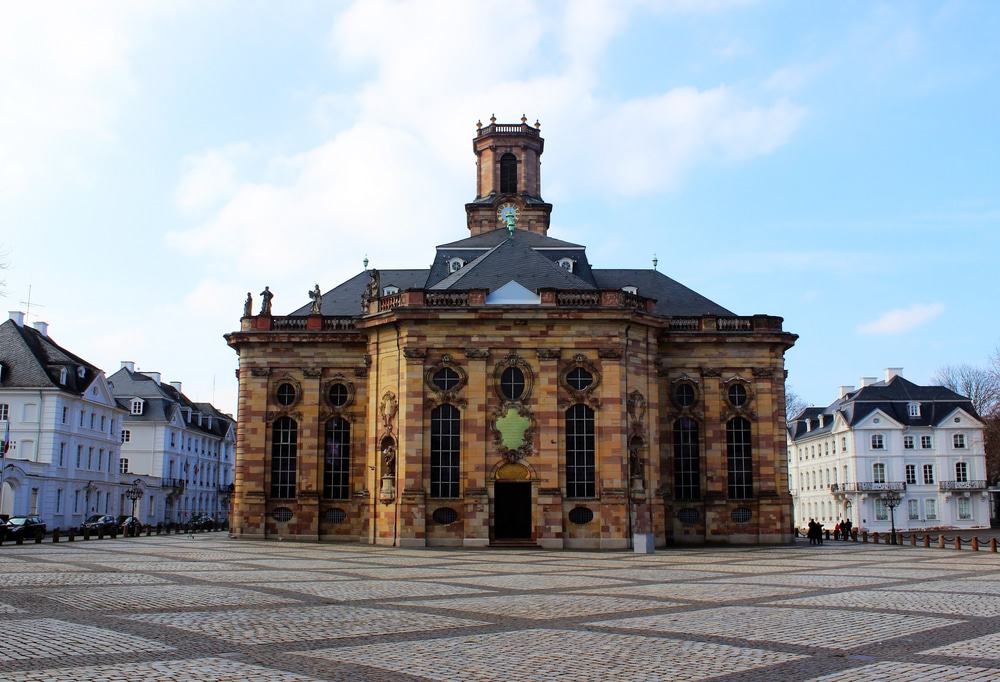Summary of Top Attractions in Saarbrücken
- Ludwigskirche
- Basilica of St. John the Baptist
- Deutsch-Französischer Garten
- Saar Historical Museum
- Völklingen Ironworks
- Museum for Pre- and Early History
- Saarlandmuseum – Moderne Galerie
- Schlosskirche
- Rathaus St Johann
- Saarbrücken Zoo
- St. Johanner Markt
- Stift Sankt Arnual
- Heizkraftwerk Römerbrücke
- Friedenskirche
- Schwenkbraten
A hair’s breadth from the French border in Southwestern Germany, Saarbrücken combines industrial history with the grandeur of the Counts and Princes of Nassau-Saarbrücken who governed the region for centuries.
Two individuals, in particular, significantly influenced Saarbrücken: the 18th-century Prince of Nassau-Saarbrücken, William Henry, and his architect Friedrich Joachim Stengel. For three decades, this duo transformed Saarbrücken into a Baroque city, erecting palaces, churches, squares, and fountains.
One of the most captivating ensembles is Ludwigsplatz, where eight palaces face the remarkable Ludwigskirche. Additionally, around Saarbrücken Castle, numerous attractions await as a network of tunnels and underground chambers have been excavated and unveiled as part of the Saar Historical Museum over the last twenty years.
Let us examine the premier sights in Saarbrücken:
1. Ludwigskirche

In the 1760s, Friedrich Joachim Stengel was commissioned by William Henry, Prince of Nassau-Saarbrücken, to construct not only this church but the adjacent square as well, creating a singular cohesive structure.
The outcome is one of the pinnacles of German Baroque art, as well as one of Germany’s distinguished Protestant churches.
Externally, you will discover statues of the four evangelists in the niches, while 28 figures representing prophets, apostles, and other biblical characters adorn the balustrades.
The pristine white interior features delicate stuccowork, with galleries on four sides supported by elegantly designed caryatids.
Stengel played a role in designing the surrounding palaces (eight still exist today), right down to the door handles.
Visit on Thursdays and Saturdays for the market.
2. Basilica of St. John the Baptist

Stengel was also accountable for another exquisite Baroque church constructed in the mid-1750s to accommodate the growing Catholic congregation of the city.
The church received partial funding from French King Louis XV, and a collection was conducted in Rome by Pope Benedict XIV. Before entering, one must examine the bronze doors, which depict scenes from the life of St. John the Baptist and were recreated in 1986 by local artist Ernst Alt following war damage.
The interior was restored to its original Baroque aesthetics in the 1970s.
Notable features include the intricate pulpit dating from 1764 and the four confessionals from 1789, each showcasing well-known repentant sinners: King David, Mary Magdalene, Saint Peter, and the thief on the cross.
3. Deutsch-Französischer Garten

To the south of Saarbrücken and just a couple of kilometers from the border crossing at Goldene Bremm, the Deutsch-Französischer Garten serves as a park with a diplomatic history.
As the name suggests, it was a collaborative initiative between the French and German governments, symbolizing friendship after Saarbrücken voted by referendum to join Germany in the 1950s.
A joint national garden show was inaugurated here, presided over by French Prime Minister Michel Debré and Chancellor Konrad Adenauer.
This park offers lawns, themed gardens, a water organ, and a large ornamental lake ideal for pedal boating. During the summer, you will find opportunities for miniature golf, a miniature railway, a cable car, and several cafes.
4. Saar Historical Museum

The size of this museum adjacent to Saarbrücken Castle can be misleading.
On the ground level, there stands a long, narrow building from 1988 with a barrel roof, which conceals a fascinating array of historic underground chambers and tunnels excavated during the 1990s and 2000s.
Within the galleries on the upper two floors, visitors can journey through the last 300 years of Saarland’s history via its art, design, and everyday artifacts.
Furthermore, descending 14 meters below Schlossplatz leads you to Saar’s Medieval and Early Modern history, traversing sections of the Medieval castle and a Renaissance casemate built in the 1560s.
5. Völklingen Ironworks

Located a few kilometers to the east of Saarbrücken along the Saar River is a UNESCO World Heritage Site.
The Völklingen Ironworks was established in 1873 and ceased operations in 1986, standing as the only smelting works from the 19th century that remains operational today.
The complex is now both an industrial monument and a science museum.
The Ferrodom, situated on the ground floor of the Möllerhalle warehouse, is dedicated to the history and science of iron processing and offers children the chance to use video microscopes for examining iron and steel surfaces and experimenting with magnetism.
Moreover, a six-kilometer trail on the site allows exploration of the enormous machinery that once processed millions of tons of ore.
Observe the six massive blast furnaces in the blasting hall and ascend to the 30-meter-high charging platform.
6. Museum for Pre- and Early History

A visit to Schlossplatz is not complete without exploring this museum housed in the former district administrative building on the southern side of the square.
The galleries chronicle thousands of years of Saarbrücken’s history, spanning from the Stone Age to the Middle Ages.
Visitors can admire handaxes, grave finds from a Celtic princess, as well as Roman coins, glassware, steles, and sculptures.
The 160-square-meter mosaic floor from the Nennig Roman villa is the largest of its kind north of the Alps, accompanied by a stunning mural from another villa in Mechern.
Also noteworthy is the museum’s Merovingian gold fibula (brooch), adorned with jewels.
7. Saarlandmuseum – Moderne Galerie

One of three branches under the Saarlandmuseum umbrella, the Moderne Galerie is located in a contemporary complex constructed in 1979, composed of three interconnected pavilions.
This exhibition showcases art from the 19th century to the present.
Highlights include the galleries focusing on German Impressionism and Expressionism from the turn of the 20th century.
Numerous prominent figures from both movements are represented, including Lovis Corinth, Max Liebermann, and Ernst Ludwig Kirchner.
However, the centerpiece is undoubtedly the Little Blue Horse, painted by Franz Marc in 1912. At the time of writing, the museum was in the process of refurbishment.
8. Schlosskirche

On the northern edge of the castle complex lies a Late Gothic church dating back to the end of the 15th century.
From 1651, this church became the burial site for the Saarbrücken dynasty, housing tombs and memorials for figures such as William Henry.
In 1743, Stengel redesigned the tower to reflect its current Baroque style.
This church suffered extensive damage during the war and has since the turn of the millennium been converted into a museum showcasing liturgical art from the Saar region.
Glass displays exhibit exquisite Romanesque, Gothic, Renaissance, and Baroque sculptures alongside various items such as candelabras and tabernacles.
9. Rathaus St Johann

A remarkable landmark is the town hall, which displays a Gothic Revival design from 1900, creating an illusion of greater antiquity. The façade boasts intricate traceried windows, pinnacles, and a wealth of ornamentation.
The central tower rises to 54 meters and features Saarbrücken’s coat of arms, along with a clock and a carillon that chimes every day at 15:15 and 19:19. Below, a series of statues represent different trades in the city dating back to the early 20th century.
Figures include a miner, an iron/steel worker, a farmer, a brewer, a merchant, and a tanner.
A statue of St. George slaying the dragon stands as a symbol of the eternal struggle against malevolence.
10. Saarbrücken Zoo

The city’s zoological park houses approximately 1,000 animals, particularly well-known for its extensive array of species originating from Africa.
The savannah species include cheetahs, giraffes, antelopes, meerkats, and black crowned cranes.
Additionally, from the African rainforests, visitors can observe gorillas, chimpanzees, mandrills, crocodiles, and red river hogs.
Head to the Afrikahaus and Tropicarium for encounters with giant tortoises, anacondas, geckos, scorpions, and even sharks.
In recent years, the zoo has undergone extensive renovations and expansions to ensure it offers a modern experience.
Since 2012, new habitats have been established for seals, penguins, lowland gorillas, meerkats, and red pandas.
11. St. Johanner Markt

For the past 40 years, the historic center of Saarbrücken has been designated as a pedestrian zone, providing a space to observe the city’s everyday life within this central square.
On Mondays, Wednesdays, and Fridays, the St. Johanner Markt features numerous stalls, forming the city’s primary market.
The square was redesigned in the Baroque style in the 1740s by none other than Friedrich Joachim Stengel, who also conceived the charming fountain on the east side.
Ensure to explore the surrounding streets: Fröschengasse is lined with former workshops now transformed into restaurants.
Furthermore, along Saarstraße, a wall chronicles the historic high water levels of the river.
12. Stift Sankt Arnual

If you have some leisure time, consider taking a stroll along the Saar from Saarbrücken Castle to the district of Sankt Arnual, one of the city’s oldest areas.
Here, you will find a 13th-century abbey church considered one of southwest Germany’s remarkable Medieval monuments.
This significance derives partly from the church serving as the burial site for a succession of Princes and Counts of Nassau-Saarbrücken up to the 15th century.
Among those interred here is Elisabeth of Lorraine-Vaudémont, one of the earliest writers in the Early New High German language.
She was the spouse of Philipp I, Count of Nassau-Weilburg and passed away in 1456.
13. Heizkraftwerk Römerbrücke

Wherever you are in Saarbrücken, you should be able to see the towering chimney of this thermal power station, which reaches a height of 177 meters.
The height of the chimney is designed to mitigate emissions in the nearby area.
Since 2014, the structure has been fitted with LEDs, producing a colorful light display at night.
The power station operates with both a gas and steam turbine while reclaiming a significant portion of its wasted energy through a thermoelectric generator.
If you wish to learn more about this process and view an architectural landmark from the inside, two-hour tours are offered on Wednesdays starting at 17:30 in front of the main gates.
14. Friedenskirche

The final notable monument on this list by Friedrich Joachim Stengel is a church constructed in the 1740s at the behest of William Henry, who provided the necessary funding and materials for its building.
Later, in 1793, during the French Revolution, the church was repurposed into a “Temple of Reason.”
For the majority of the 19th century, the building served as a school, where an event occurred in 1871 that continues to resonate today.
Julius Becker, a troubled student, shot two classmates, both of whom survived, albeit with significant injuries.
Notably, Becker was acquitted during his trial due to claims of “temporary incapacity.”
15. Schwenkbraten

In Saarland, summer heralds the arrival of an event known as Schwenker.
This primarily involves swinging grills suspended from tripods over a beech wood fire.
These grills can be seen smoking at most beer gardens in Saarbrücken.
The dish to savor is Schwenkbraten, which consists of marinated pork neck steaks seasoned with green herbs or paprika, barbecued over the flames, and topped with onions.
Typically served alongside pasta or potato salad, this delicacy pairs well with a glass of pilsner lager.
Other traditional items grilled on these installations include German bratwurst, French merguez sausages, and potatoes, often accompanied by toasted baguettes.





